
Within the journey of self-discovery by way of yoga, we frequently encounter a profound idea that lies on the coronary heart of our interior exploration: “Vrittis.”
Vrittis are the ripples on the floor of the nonetheless lake of our consciousness, the chattering of the thoughts that may obscure the readability of self-realization. To delve into the depths of yoga is to navigate these fluctuations and achieve mastery over them, finally resulting in a profound understanding of oneself.
On this article, we’ll discover the essence of Vrittis in yoga. We are going to unravel the which means of Vrittis, delve into the importance of the “Chitta Vritti,” and uncover the profound knowledge embedded within the 5 distinct Vrittis described by Patanjali.
What Are Vrittis in Yoga?
Vrittis, usually described because the “fluctuations of the thoughts,” type a elementary idea within the philosophy of yoga. These psychological fluctuations are central to understanding the workings of the thoughts and the trail towards self-realization as outlined in Patanjali’s Yoga Sutra.

Defining Vrittis: At its core, the time period “Vrittis” refers back to the whirlpool of ideas, feelings, and psychological actions that consistently occupy our consciousness. These fluctuations might be in comparison with the ripples on the floor of a serene lake, disrupting its tranquillity.
Chitta Vritti: To know the essence of Vrittis, we should delve into the Sanskrit time period “Chitta Vritti.” Whereas usually translated as “thoughts chatter” or “psychological waves,” Chitta Vritti encompasses rather more.
Chitta represents the whole lot of consciousness in an individual, and Vrittis are the thought patterns that emerge from it. These thought impulses might be fickle, chaotic, and disruptive, stopping us from experiencing our true nature.
The Quest for Self-Realization: Patanjali, the traditional sage and writer of the Yoga Sutra, acknowledged that true self-realization might solely be attained when the Chitta is liberated from the burdens of those Vrittis. Each follow inside the realm of yoga, whether or not it’s the bodily postures (Asana), breath management (Pranayama), meditation, or non secular exploration, is finally geared toward this one profound objective – self-realization.
The 5 Vrittis
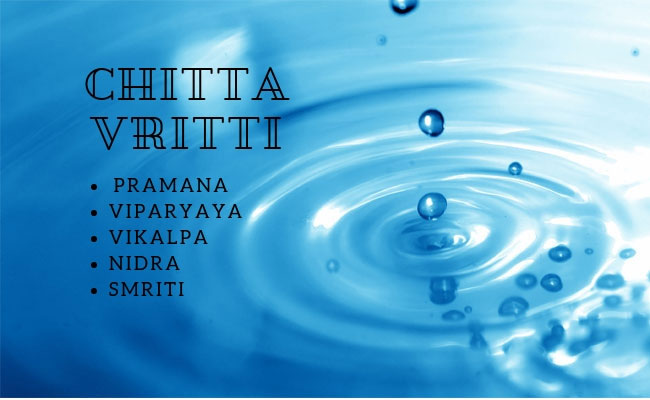
Patanjali’s Yoga Sutra categorizes Vrittis into 5 sorts, every with its distinctive traits and results on the thoughts.
- Proper Cognition (Pramana): It refers back to the capability to understand info accurately primarily based on our beliefs, experiences, and ethical values.
- False impression (Viparyaya): This vritti happens when the thoughts incorrectly interprets sensory info.
- Creativeness (Vikalpa): This vritti represents the thoughts’s capability to create psychological photographs, fantasies, and daydreams.
- Sleep (Nidra): This vritti is extra than simply the absence of wakefulness. It’s an altered state of consciousness the place the thoughts’s thought patterns are considerably lowered.
- Reminiscence (Smriti): Smriti, or “reminiscence,” entails the recollection of previous sensations or feelings, each aware and unconscious.
Every of those 5 Vrittis performs a definite function in shaping our notion, ideas, and consciousness. By delving into their particular person traits and results, we achieve a deeper understanding of how they contribute to the tapestry of our psychological panorama. Be part of us as we discover every Vritti intimately and uncover their significance within the follow of yoga.
1. Proper Cognition (Pramana)
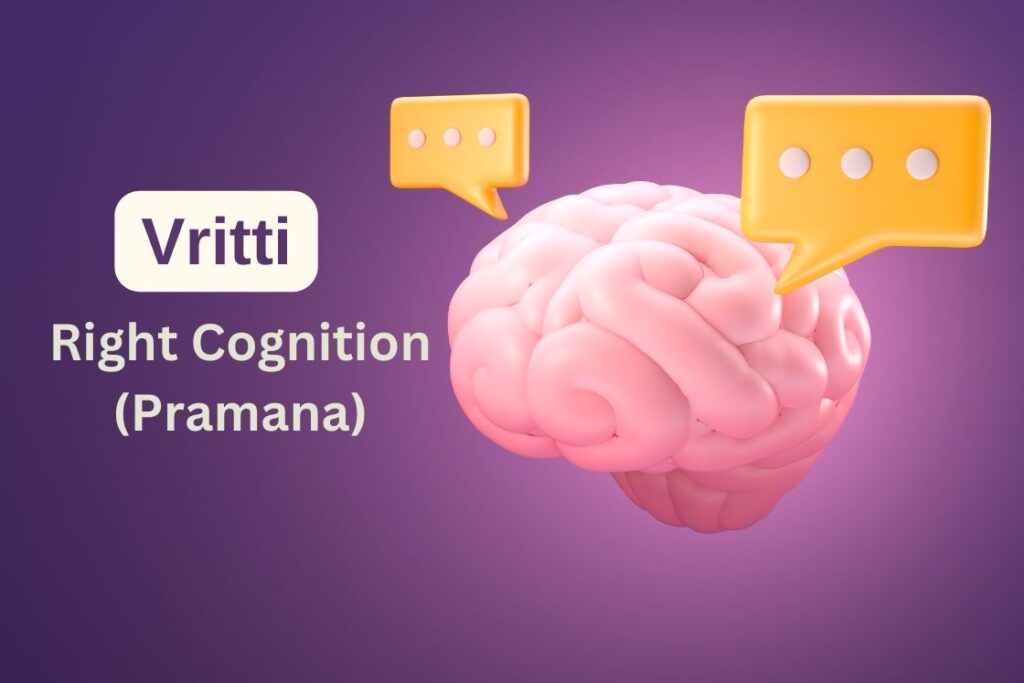
Within the huge realm of psychological fluctuations often called Vrittis, “Pramana” stands because the pillar of proper cognition. This Vritti revolves round our capability to understand info precisely, making it an indispensable facet of our cognitive colleges.
Pramana basically represents the thoughts’s quest for reality and data primarily based on perception, expertise, and ethical values.
The Six Forms of Pramana Vrittis
Inside the realm of Pramana, the thoughts employs a various set of instruments to find out the validity of knowledge. These six varieties of Pramana Vrittis are important to our understanding of the world:
- Direct Expertise (Pratyaksha): That is probably the most easy type of Pramana, counting on sensory notion. What we see, hear, style, contact, and odor instantly informs our understanding of actuality.
- Inference (Anumana): Inference entails drawing conclusions primarily based on observations. For instance, if we see smoke, we infer the presence of fireside.
- Comparability (Upamana): Upamana Pramana depends on comparability. After we relate one thing new to one thing acquainted, we achieve insights. As an illustration, a brand new fruit is described as “apple-like.”
- Postulation (Arthapatti): This type of Pramana helps us perceive situations the place direct proof is missing. For instance, if an individual by no means eats throughout the day however stays wholesome, we postulate that they eat at evening.
- Non-apprehension (Anupalabdhi): Anupalabdhi is the notion of the absence of one thing. It’s the popularity that one thing we anticipated to see or expertise is just not current.
- Verbal Testimony (Sabda): This entails gaining data from credible sources, akin to lecturers, books, or specialists. It’s an essential Pramana because it allows us to entry data past our direct experiences.
Balancing Perception and Actuality
Whereas Pramana Vritti empowers us to accumulate data, it’s essential to acknowledge that what we understand as true might not maintain the identical reality for another person. Perception programs, previous experiences, and particular person views affect our understanding of actuality. As seekers of self-realization, the popularity of those particular person variations turns into very important.
In our journey to grasp Pramana and its function in Vrittis, we navigate the trail of discernment and knowledge. The flexibility to distinguish between private perception and goal actuality is a stepping stone towards readability and self-realization.
2. False impression (Viparyaya)
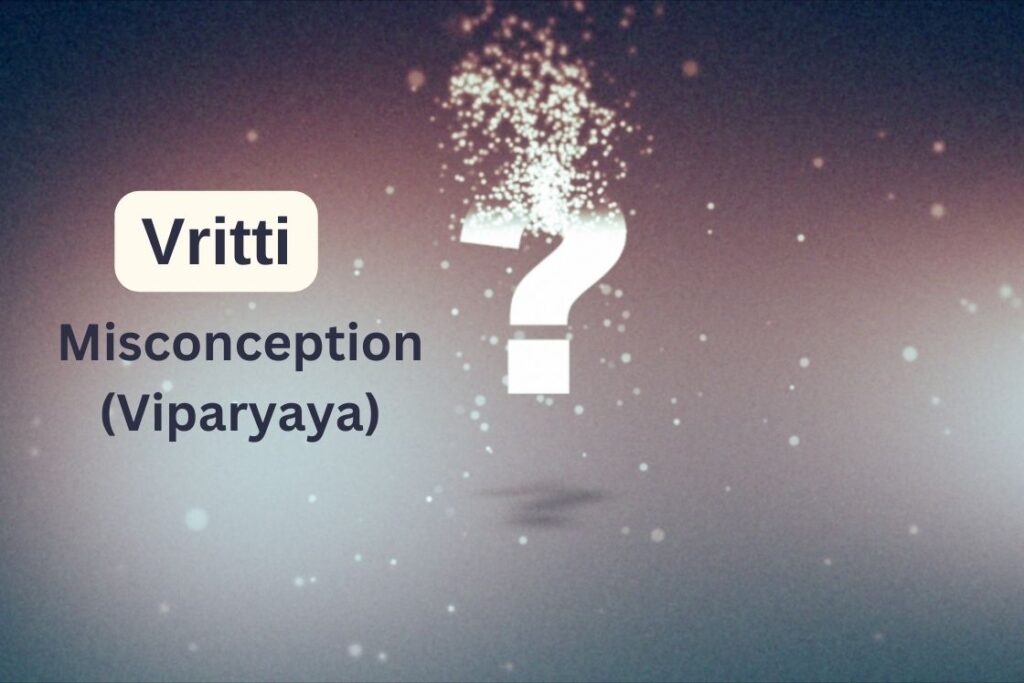
Viparyaya, also known as “false impression,” represents one of many 5 Vrittis that form our psychological panorama. This Vritti happens when the thoughts incorrectly interprets sensory info, resulting in a distortion of actuality.
Within the intricate tapestry of the thoughts’s fluctuations, Viparyaya might be likened to a mirage, the place what we understand might not align with the reality.
The Mirage Impact

For example Viparyaya, take into account the traditional instance of a mirage within the desert. From a distance, one would possibly see what seems to be a shimmering pool of water on the arid horizon. The senses sign the presence of water, and the thoughts interprets it as an actual physique of water. Nonetheless, upon nearer examination, it turns into evident that there is no such thing as a water, and the mirage dissipates.
This mirage impact encapsulates the essence of Viparyaya vritti. It highlights how our sensory perceptions can deceive us, resulting in a false understanding of actuality. It serves as a reminder that our senses, whereas highly effective, aren’t infallible. The thoughts’s tendency to misread sensory enter can create illusions that hinder our path to self-realization.
The Quest for Readability
Within the pursuit of self-realization by way of yoga, readability and correct notion are paramount. Recognizing the presence of Viparyaya inside our psychological panorama is step one towards dispelling the fog of false impression. By acknowledging that our senses can generally lead us astray, we open the door to a extra profound understanding of the true nature of actuality.
3. Creativeness (Vikalpa)
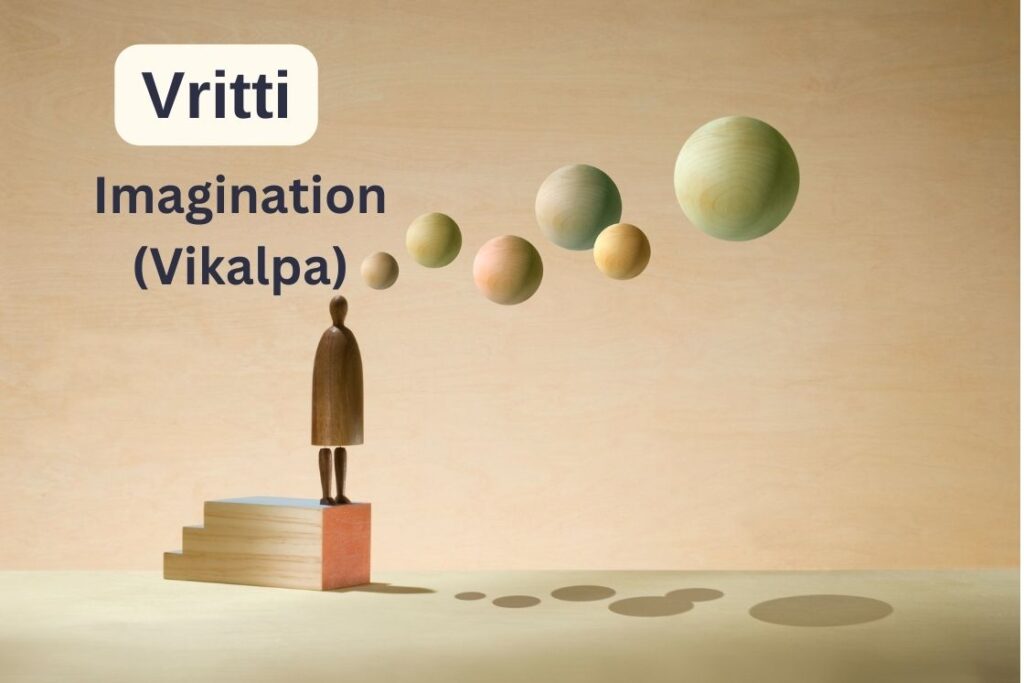
Vikalpa, usually related to creativeness, is an enchanting Vritti that explores the artistic depths of the thoughts. This psychological fluctuation permits us to conjure psychological photographs, fantasies, and daydreams. Whereas creativeness generally is a wellspring of inspiration and innovation, it additionally has the potential to guide the thoughts astray if left unchecked.
Managed Creativeness (Kalpana)
One side of Vikalpa value exploring is managed creativeness, often called “Kalpana.” This type of creativeness serves as a useful device for setting and reaching targets, problem-solving, and nurturing creativity. Managed creativeness permits us to examine prospects, plan for the long run, and produce our desires to life.
Think about an artist who envisions a masterpiece earlier than placing a brush on canvas or an architect who mentally constructs a constructing earlier than it stands in actuality. These are examples of managed creativeness at work, harnessing the thoughts’s artistic energy for constructive functions.
Uncontrolled Creativeness (Vikalpa)
Conversely, uncontrolled creativeness (Vikalpa) might be likened to a wandering thoughts misplaced in fantasy. It usually results in daydreaming, doubt, and indecision. Whereas temporary moments of wandering creativeness might be innocent, unchecked Vikalpa Vritti can turn into a supply of distraction and psychological turmoil.
Consider a second if you discovered your self misplaced in an elaborate daydream, indifferent from the current actuality. This can be a manifestation of uncontrolled creativeness. It diverts the thoughts from its supposed focus and should hinder productiveness and self-realization.
The Function of Yoga
Within the follow of yoga, notably in meditation and focus workouts, we study to harness and management the imaginative Vritti. By growing the flexibility to direct our creativeness purposefully, we achieve mastery over Vikalpa. This management permits us to channel artistic power and use it as a robust drive for self-realization.
Managed creativeness, together with centered meditation, can result in profound insights and heightened consciousness. It empowers us to visualise our targets, domesticate optimistic ideas, and pave the way in which for transformation. By disciplined follow, we uncover that the thoughts, beneath our steerage, generally is a wellspring of inspiration and self-discovery.
4. Sleep (Nidra)

Nidra, the Vritti of sleep, introduces us to an altered state of consciousness that’s each mysterious and profound. Within the panorama of psychological fluctuations, Nidra represents a singular state the place the thoughts’s thought patterns are considerably lowered. It’s a state the place we expertise relaxation and restoration, but it surely’s not merely the absence of wakefulness.
Nidra is akin to the moments simply earlier than falling asleep or these proper upon waking. It’s a state the place the thoughts’s common chatter subsides, and we discover ourselves in a realm the place ideas are minimal, if not absent. It’s a transient state that holds nice potential for self-discovery and transformation.
The Significance of High quality Sleep
High quality sleep is important for our total well-being, each bodily and mentally. Nidra not solely permits the physique to rejuvenate but in addition presents the thoughts a reprieve from the incessant thought waves of the waking state. It’s throughout these moments of relaxation that we discover a sense of interior peace and stability.
Patanjali acknowledged the importance of experiencing peace of thoughts throughout deep sleep. In Yoga Sutra (1.38), he emphasizes the worth of finding out desires and deep sleep states as a method to stabilize the thoughts. This suggests that sleep, when approached mindfully, can contribute to our interior journey.
Yoga Nidra Apply
Inside the realm of yoga, there exists a robust follow often called “Yoga Nidra.” This historical meditation follow permits people to consciously expertise the exercise of deep sleep whereas remaining awake and conscious. Yoga Nidra guides practitioners by way of a state of deep leisure, the place they turn into observers of their ideas and sensations.
Yoga Nidra offers a singular alternative to discover the depths of consciousness whereas retaining a way of mindfulness. It permits us to entry the tranquil state of Nidra deliberately, somewhat than experiencing it solely as an unconscious a part of our every day cycle.
5. Reminiscence (Smriti)
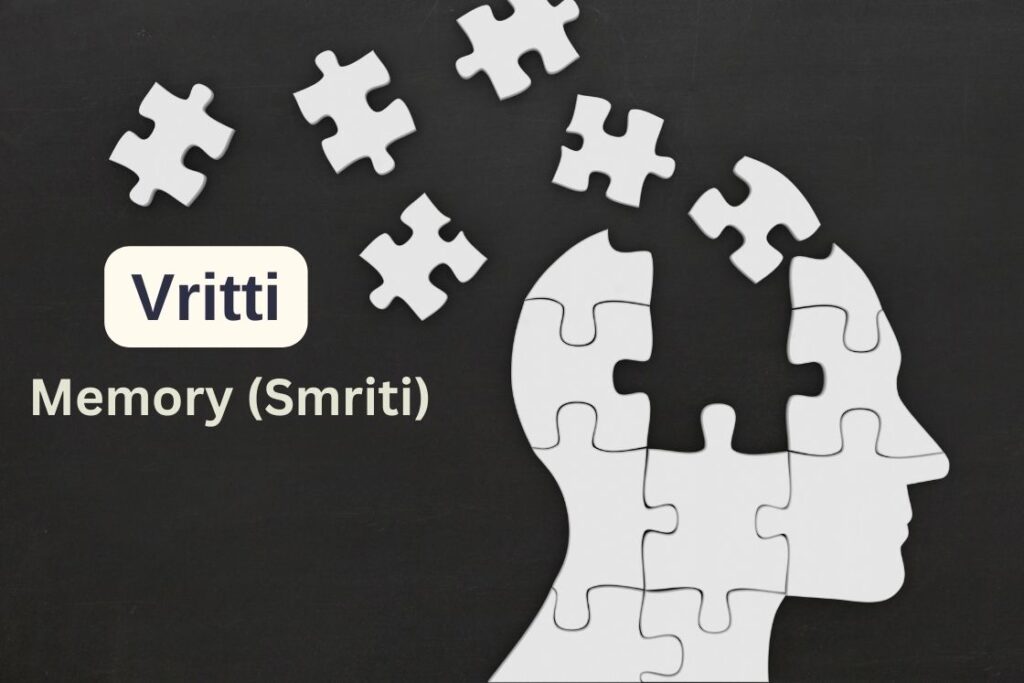
Smriti, also known as “reminiscence,” is a Vritti that takes us on a journey by way of the corridors of our previous. It entails the recollection of lasting impressions, each aware and unconscious, which were printed on the canvas of our thoughts by previous sensations and feelings.
Consider Smriti because the psychological archive that shops our life’s experiences, each vital and mundane. It encompasses reminiscences of pleasure, sorrow, love, and numerous different feelings, every with its distinctive vibrancy and texture. These reminiscences form our notion of the world and affect our responses to current conditions.
Affect on Current Experiences
Smriti performs a vital function in shaping our current second. It impacts our temper, selections, and interactions with the world. After we encounter a state of affairs, Smriti acts as a lens by way of which we view it. The reminiscences we recall can both elevate our spirits or solid a shadow on our experiences.
For instance, a optimistic reminiscence of a previous achievement can increase our confidence, whereas a destructive reminiscence might set off anxiousness or self-doubt. Smriti’s affect on our present frame of mind is profound, and it may well both facilitate our journey towards self-realization or hinder it.
Minimizing Previous Influences
The follow of yoga, notably meditation and one-pointed focus, goals to reduce the impression of previous experiences saved in Smriti. By cultivating mindfulness and residing within the current second, we are able to study to detach from the emotional cost of reminiscences.
Vrittis in Hindu Philosophy
Whereas the idea of Vrittis is prominently mentioned within the context of Patanjali’s Yoga Sutras, it’s essential to acknowledge that these psychological fluctuations additionally maintain significance inside Hindu philosophy.
In Hindu philosophy, Vritti is commonly described primarily based on the inspiration of Samskara. Samskara represents the results of our previous karma, the actions and deeds that accumulate over lifetimes. These gathered impressions give route to our feelings, behaviors, and responses to numerous life conditions.
Vrittis, on this context, might be seen because the cyclical patterns of thought and conduct that come up from Samskara. They’re like ripples that preserve us certain to sure objects or attachments within the exterior world, thus creating disturbances in realizing greater consciousness.
These psychological fluctuations, pushed by previous actions and impressions, can both propel us deeper into the cycle of delivery and loss of life (samsara) or function a method to transcend it. It’s the latter objective that aligns Vrittis with the non secular pursuits of self-realization and liberation (moksha).
Controlling Vrittis by way of Yoga

Within the earlier sections, we delved into the intricacies of Vrittis, these ever-changing psychological fluctuations that affect our perceptions, feelings, and behaviors. Now, let’s discover how the follow of yoga serves as a robust device for controlling and mastering these Vrittis, finally guiding us in the direction of self-realization and interior peace.
1. Consciousness and Self-Remark
The journey in the direction of controlling Vrittis begins with self-awareness. Yoga encourages us to turn into observers of our personal minds. By methods like mindfulness meditation, we study to look at the ebb and circulate of ideas with out getting entangled in them. This consciousness is step one in gaining mastery over Vrittis.
2. Asana Apply
Bodily postures or asanas are an integral a part of yoga follow. Past their bodily advantages, asanas additionally impression the thoughts. They assist launch bodily stress and, in flip, scale back psychological agitation. The follow of asanas prepares the physique and thoughts for meditation, the place the true work of Vritti management usually takes place.
3. Pranayama for Thoughts Management
Pranayama, or the follow of controlling the breath, has a direct affect on the thoughts. By regulating the breath, we are able to calm the thoughts and scale back the fluctuations of Vrittis. Pranayama methods like Nadi Shodhana (alternate nostril respiratory) and Ujjayi (oceanic breath) are notably efficient in reaching psychological readability.
4. Focus and Meditation:
Focus and meditation are potent instruments for mastering Vrittis. Dharana (focus) entails focusing the thoughts on a single level, akin to a mantra or the breath. This follow enhances psychological self-discipline and step by step reduces the affect of Vrittis.
Meditation, or Dhyana, takes this course of a step additional. It entails sustained focus and the gradual quieting of the thoughts. In deep meditation, the Vrittis subside, permitting us to expertise moments of profound stillness and self-realization.
5. Yoga Nidra
As mentioned earlier, Yoga Nidra is a specialised follow that permits us to expertise deep leisure whereas sustaining consciousness. It’s a robust technique for exploring the refined realms of consciousness and minimizing the impression of Vrittis throughout the state of Nidra.
6. Cultivating a Yogic Life-style
Yoga isn’t restricted to what occurs on the mat or throughout formal meditation periods. It’s a holistic lifestyle that extends into our every day actions. By practising the ideas of yoga, together with non-attachment (Vairagya) and self-discipline (Tapas), we step by step loosen the grip of Vrittis on our lives.
7. Search Steerage and Research
Yoga is an enormous and profound science. Search steerage from skilled lecturers and immerse your self within the examine of yogic philosophy. Understanding the deeper ideas of yoga and the character of the thoughts can present useful insights into Vrittis and their management.
8. Persistence and Endurance
Controlling Vrittis is just not an in a single day achievement. It’s a lifelong journey that requires persistence and persistence. Be light with your self, and do not forget that setbacks are a pure a part of the method. Every step you’re taking brings you nearer to mastering your psychological fluctuations.
Conclusion: Mastering Vrittis for Interior Peace and Self-Realization
Vrittis are the ever-changing psychological fluctuations, encompassing ideas, feelings, and patterns of the thoughts, on the coronary heart of yoga philosophy. These Vrittis are primarily of 5 sorts Proper Cognition (Pramana), False impression (Viparyaya), Creativeness (Vikalpa), Sleep (Nidra), and Reminiscence (Smriti), every with its distinctive affect on our every day lives and non secular journey.
Controlling Vrittis is central to the follow of yoga, and it begins with self-awareness and mindfulness. By partaking in yogic methods akin to meditation, asanas, pranayama, and focus, people can achieve mastery over these psychological fluctuations. By a constant yogic life-style and unwavering dedication, one embarks on a transformative journey towards self-realization, unlocking the profound interior peace that lies past the realm of Vrittis. The trail could also be difficult, however with persistence and self-compassion, it results in the belief that the fluctuations of the thoughts aren’t obstacles however stepping stones towards reaching our highest potential.
FAQs on Vrittis in Yoga
Vrittis are the fluctuations of the thoughts, encompassing ideas, feelings, and psychological patterns. They’re essential in yoga as a result of they’ll both hinder or facilitate our journey in the direction of self-realization.
Begin by practising mindfulness meditation. Sit quietly, observe your ideas with out judgment, and word any recurring patterns or feelings. This self-awareness is step one in recognizing and understanding your Vrittis.
Whereas full elimination of Vrittis could also be difficult, the objective in yoga is to realize management over them. With follow, you possibly can considerably scale back their affect and expertise moments of psychological stillness and readability.
The challenges in controlling Vrittis range from individual to individual. Some might discover the Vritti of Creativeness (Vikalpa) notably difficult, whereas others might wrestle with False impression (Viparyaya). It is dependent upon one’s distinctive psychological tendencies and conditioning.
Sure, Vrittis can have optimistic features. Managed creativeness (Kalpana) can foster creativity, and proper cognition (Pramana) helps us discern reality. Nonetheless, the important thing lies in managing them successfully and never letting them dominate our consciousness.
